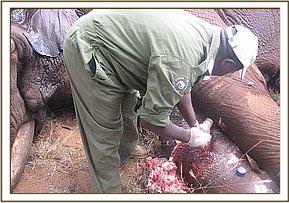There were 11 interventions this month of which nine were due to injuries from human causes while two were from natural causes
There were 11 interventions this month of which nine were due to injuries from human causes while two were from natural causes. Of the nine cases due to human causes, five were from arrows, one from a spear and two from snaring while the last was from a car accident.
Three of the cases from arrows involved rehabilitated elephants released into the wild about two years ago. One of these elephants christened Lolokwe had two arrow heads one lodged at the right shoulder and the other at the right fore leg. 













The fourth elephant with an arrow head deeply lodged at the medial aspect of the right fore leg was treated at Rukinga ranch. The injury was heavily infected and extensively spread under the skin. Necrotic tissues were debrided after cleaning the wound. It was topically treated and an antibiotic cover given. 





On the 28th another juvenile elephant was also treated for an arrow injury near the Voi gate. The injury was mildly infected and in the process of recovering. It had no foreign object inside. 



The spear injury also involved a bull elephant at Ol Donyo Wuas sanctuary in the Chyulu Hills. The injury was at the lower right hind leg and was mildly infected but deep. The prognosis for its recovery was good. We have received reports that the elephant is frequently seen at the sanctuary water hole and has recovered. 



The snare was removed from a 4-year-old elephant at Taita Salt Lick sanctuary. The snare was tight and had inflicted some injury on the left ear and the neck but the prognosis was good. 


The second elephant with a snare was also treated at the Salt Lick sanctuary on the 28th. The winch cable snare was so tight and deeply embedded causing a severe and extensive injury. Very high doses of an antibiotic were given and the wound cleaned thoroughly. The sanctuary scouts will keep an eye on it and monitor progress so that a second treatment can be administered if found necessary after about two weeks. 







A zebra foal was knocked by a vehicle at Manyani shopping centre and sustained multiple fractures at different levels of the left hind leg. It was euthanised with 20% pentobarbital sodium intravenously to stop further suffering because no treatment was feasible under field conditions. 

Report by: Dr. David Ndeereh
The Mobile Veterinary Unit operated by The David Sheldrick Wildlife Trust working with The Kenyan Wildlfie Service and funded by Vier Pfoten